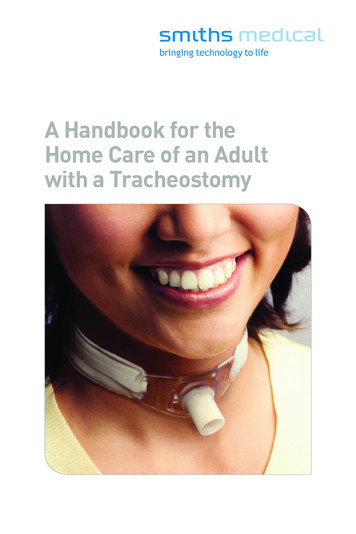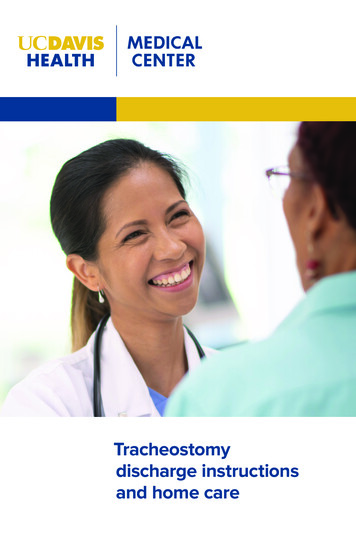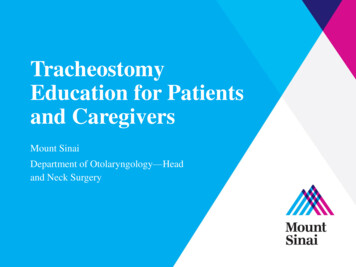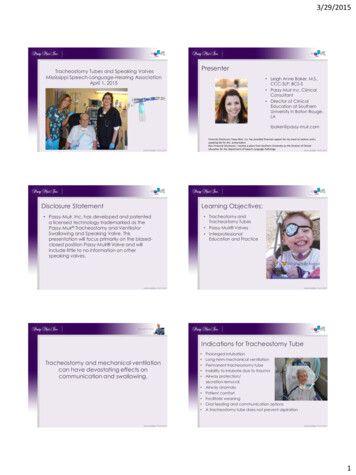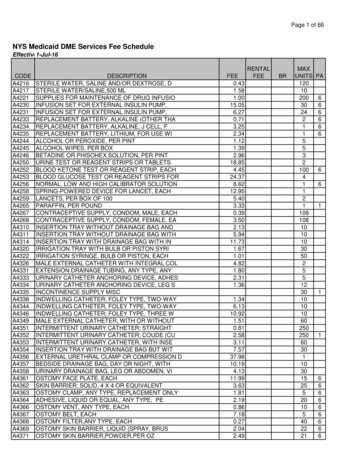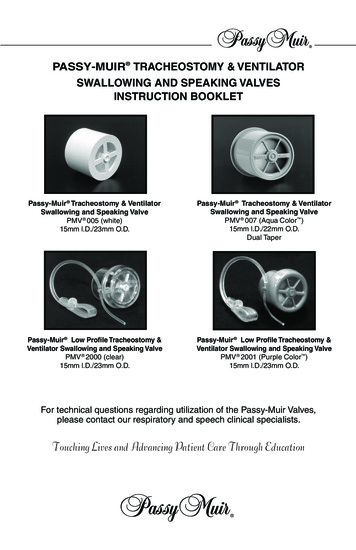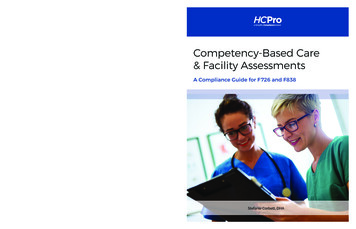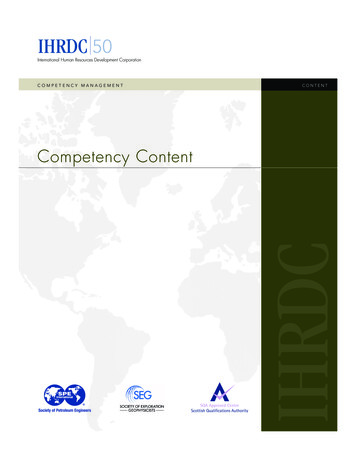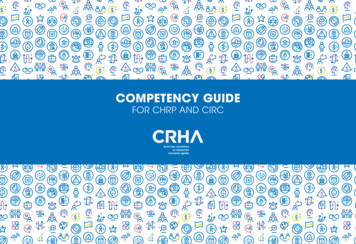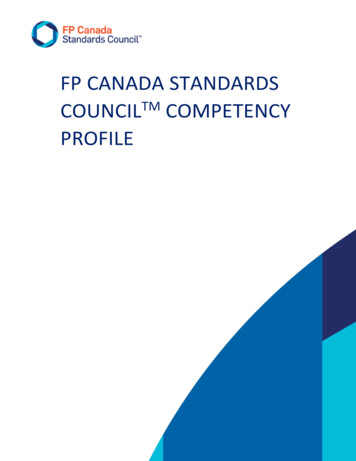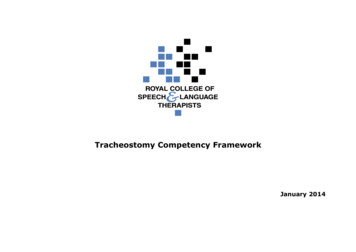
Transcription
Tracheostomy Competency FrameworkJanuary 2014
Key ContributorsVicky Thorpe Cert MRCSLT, MSc, BScSpecialist Speech and Language Therapist –ENT/DysphagiaGreat Ormond Street Hospital NHS Foundation TrustGreat Ormond StreetLondon WC1N 3JH020 7813 8110 or 020 7405 9200Vicky.thorpe@gosh.nhs.ukSarah WallaceClinical Coordinator in DysphagiaUniversity Hospital of South ManchesterDept Speech voice and SwallowingSouthmoor RoadWythenshaweManchester M23 9LT0161 291 2864Sarah.wallace@uhsm.nhs.ukNatasha MorrowAdvanced Specialist Speech and Language Therapist (Head and Neck Oncology)Guy's Hospital,Speech & Language Therapy Department,Ground floor, Tower Wing,Great Maze Pond,London SE1 9RTTel: 0207 188 6233natasha.morrow@nhs.net
Aeron GinnellyAdvanced Specialist Speech and Language Therapist Critical CareSt Thomas' HospitalWestminster Bridge RoadLondon SE1 7EHAeron.ginnelly@gstt.nhs.ukSue McGowanClinical Specialist SLTNational Hospital for Neurology and NeurosurgeryQueen Square,London WC1N 3BGSusan.mcgowan@uclh.nhs.ukMs Lynne ClarkClinical lead Acute Speech and Language TherapyKing's College HospitalDenmark HillLondon, SE5 9RSTel 020 3299 9000Dr. Kate ReidHead of Speech and Language TherapyTherapy - University Hospitals Birmingham NHS Foundation TrustQueen Elizabeth Hospital, Queen Elizabeth Medical Centre,Birmingham, B15 2THKate.Reid@uhb.nhs.uk / 0121 371 3804
Sarah HaynesConsultant Speech and Language TherapistThe Royal Hospital for Neuro-disability,West Hill,Putney,London SW15 3SWTel 0208 7804500Amy PundoleClinical LeadThe Royal Hospital for Neuro-disability,West Hill,Putney,London SW15 3SWapundole@rhn.org.uk
Royal College of Speech and Language Therapists Tracheostomy Competency FrameworkContentsPageSection 1 Introduction6Section 2 Core tracheostomy skills7Section 3 Attainment of competency15Section 4 Maintenance of competencies15Section 5 Critical care tracheostomy competencies16Section 6 Head and neck competencies17Section 7 Paediatric competencies19Section 8 Burns tracheostomy competencies21Section 9 Community and/or long-term tracheostomy competencies23Section 10 References/reading lists25RCSLT Tracheostomy Competency Framework 2014Page 5
Section 1 IntroductionThe core competencies below reflect guiding principles in tracheostomy care to guide safe and best practice.We have not repeated the core competencies in each specialist section. Please refer to the core tracheostomy competenciesin conjunction with the specialist sections.All the core competencies and skills will need to be tailor made in relation to your job description, client group and setting.This may include appropriate terminology for your client group. In the competencies below we have used the term ‘whereindicated’ to prompt you in this respect.Where possible we have tried to group the contents but the groupings are not exhaustive.You will need a tracheostomy mentor to guide you through this competency process. Depending on resources, this may besomeone outside of your existing team. You may need to use local networks to identity a suitable person. For thecompetencies relating to communication, swallowing and SLT professional skills the tracheostomy mentor must be anotherSpeech and Language Therapist working with patients with tracheostomies. For the more generic tracheostomycompetencies the mentor may be another multidisciplinary team (MDT) member e.g. clinical nurse specialise orphysiotherapist.SLT suctioning is not covered within the scope of this document.Pre-requisite core skillsIndependent in the management of dysphagia and communication in non-tracheostomised patients within the same settingand client group as the tracheostomised patients.RCSLT Tracheostomy Competency Framework 2014Page 6
Section 2 Core tracheostomy skillsTheoretical tracheostomy knowledgeExamples of methods of theoretical knowledge acquisition: Reading books, journals and trache company literature/websites (refer to reading list at end of this document) Discussion with reps/nurses/physios, anaesthetists, etc. Attendance at courses e.g. basic tracheostomy day Tutorial with tracheostomy mentor Reading local protocols Observing colleagues in MDT Case scenarios Visits to other hospitals External supervision Invite trainers to your department Reflective logTheoretical knowledge requiredMethod of acquisitionEvidence ofachievementKSF levelDate andsignAnatomical/physiological1. Anatomical and physiological changeswhen a tracheostomy is in situ2. Physiological changes whentracheostomy tube is manipulated3. Impact of tracheostomy on voiceproduction and airway4. Relevant literature regarding impact oftracheostomy tubes on speech andswallowingRationale, method5. Reasons for requirement oftracheostomy tubeRCSLT Tracheostomy Competency Framework 2014Page 7
Theoretical knowledge requiredMethod of acquisitionEvidence ofachievementKSF levelDate andsign6. Different methods for tracheostomyinsertion and their risks and benefits7. Risks and benefits of tracheostomyComplications, impact8.Complications of tracheostomy (longand short term)9. Awareness of complications andimpact of previous/ongoing airwaymanagement e.g. ventilation andintubation10. Knowledge of the signs of respiratorydistress11. Identify potential emergencysituations and how to respondappropriately12. Impact of tracheostomy onpsychosocial functioning of patiente.g. on family and relationships, bodyimage, community support,education, etc.Equipment13. Understand and describe a range ofdifferent tube types, from tubes usedin standard practice to morespecialised tubes, their function,rationale for use and contraindications14. Label accessories e.g. speakingvalve/one way valve/HME/cap etc.15. Essential bedside equipment as perlocal policyRCSLT Tracheostomy Competency Framework 2014Page 8
Theoretical knowledge requiredMethod of acquisitionEvidence ofachievementKSF levelDate andsignSwallowing assessment16. Current literature on modified Evansdye testing and its limitations foraspiration detection17. Indications for oral and trachealsuctioning18. Understands the limitations of aclinical swallowing assessment in thepresence of an inflated cuff19. Awareness of use and timing ofdifferent instrumental tools (e.g.Fibreoptic Endoscopic Evaluation ofSwallowing (FEES), Videofluoroscopy(VFS) to assess laryngeal integrity forphonation, secretion management andswallow function20. Limitations of cervical auscultation(especially in cuff inflated patients)21. Knowledge of the value andlimitations of pulse oximetry intracheostomymanagement/swallowing assessmentCuff deflation, communication,speaking valves22. Cuff deflation - complications, safetyand timing, impact on respirationfunction, secretion management andswallowing23. Impact of speaking valve/one-wayvalve on physiology of speech,RCSLT Tracheostomy Competency Framework 2014Page 9
Theoretical knowledge requiredMethod of acquisitionEvidence ofachievementKSF levelDate andsignswallow, respiratory workload24. Different types of speaking valves/oneway valves, their function, limitationsand impact on weaning25. Indications and contraindications forspeaking valve/one-way valve use26. Understands the circumstances forfeeding with an inflated cuff and SLTrole in this, i.e. palliative/quality oflife/patient choiceWeaning27. Process and timing of weaning anddecannulation includingindications/contraindications28. Knowledge of medications and theirimpact on tracheostomy weaning29. Awareness of relevant patient comorbidities and their potential impacton weaning30. The role of different tracheostomytubes (e.g. fenestrated tubes) in theweaning processRoles and policies31. Role of SLT in tracheostomymanagement in specific setting32. Roles of other MDT members33. Knowledge of the implications of ear,nose and throat (ENT) findings onphonation, swallowing and weaningand likely interventionsRCSLT Tracheostomy Competency Framework 2014Page 10
Theoretical knowledge requiredMethod of acquisitionEvidence ofachievementKSF levelDate andsign34. Awareness of outcomes measuresrelated to tracheostomy management35. Local tracheostomy policies andnational guidelines36. Local infection control policypertaining to tracheostomies e.g.personal protective equipment, visorsCore practical tracheostomy skills:Examples of methods for practical skill acquisition Practice on models (Trache Tom) Observe on ward rounds/school visit/community clinic Carry out with patientsNote: There is no assumption made about the numbers of patients you have to see to achieve these competencies; thisshould be decided with your tracheostomy mentor in accordance with your needs, job requirements and clinicalsetting.Skills requiredMethod of acquisitionEvidence ofachievementKSF levelDate andsignRationale, method1. Identify reason from case history fortracheostomy insertionComplications, impact2. Recognises signs of respiratory distressand manages appropriately3. Recognises signs of cuff leak in aninflated cuffRCSLT Tracheostomy Competency Framework 2014Page 11
Skills requiredMethod of acquisitionEvidence ofachievementKSF levelDate andsign4. Able to describe impact oftracheostomy on communication andswallowing to patient and carersEquipment5. Identify type, size and cuff status oftracheostomy6. Able to remove, clean and reinsertinner tube according to local policy7. Able to use equipment e.g. cuffpressure manometer, pulse oximeter8. Able to give relevant information topatients about the tracheostomy tube9. Able to advise the MDT on selection oftubesSwallowing assessment10. Able to recognise aspiration signs inrelation to a tracheostomy tube, e.g.identifying food/fluid stained secretionsfrom trache on suctioning or stoma11. Able to recognise signs of aspirationaround an inflated tracheostomy cuff12. Able to use blue dye as an adjunct toclinical bedside assessment ofswallowing, acknowledging thesignificant limitations of the test13. Able to document clearly all aspectsof tracheostomy assessment andmanagementRCSLT Tracheostomy Competency Framework 2014Page 12
Skills requiredMethod of acquisitionEvidence ofachievementKSF levelDate andsign14. Provide dysphagia, communicationand therapy recommendationsappropriate to tracheostomised patientsin the particular care settingCuff deflation, communication,speaking valves15. Able to deflate cuff with simultaneoussuction by an appropriately trainedmember of MDT16. Able to advise cuff deflation protocolas part of MDT17. Able to advise patient/family/MDT reeffects of cuff deflation on voice andswallowing18. Able to finger occlude to assess voice19. Able to place speaking valve/one-wayvalve, and remove safely andappropriately20. Able to assess speaking valve/oneway valve tolerance, voice quality andtrouble shoot any difficulties21. Able to re-inflate cuff and ensure thatcuff pressure is checked in accordancewith local policyWeaning22. Able to contribute SLT findings andtheir implications to team re:tracheostomy weaning anddecannulation23. Able to adapt tracheostomy weaningadvice according to plans forRCSLT Tracheostomy Competency Framework 2014Page 13
Skills requiredMethod of acquisitionEvidence ofachievementKSF levelDate andsignsurgical/theatre interventionsTraining others24. Educates other MDT/family membersand patient about the impact oftracheostomy on communication andswallowing and the appropriate use ofone-way/speaking valve and HeatMoisture Exchange devices (HMEs)25. Able to advise on speaking valve/oneway valve protocol as part of MDT andtrain other professionals as necessaryRCSLT Tracheostomy Competency Framework 2014Page 14
Section 3 Attainment of competencyOnce you have demonstrated these skills in theory, you need to demonstrate competency in the generalisation of knowledge,skills and decision making in relation to specific patient’s assessments in your setting.This can be done in a number of ways, but a suggested framework is as follows:Practical application of knowledgeEvidenceObservation, shadowingTake detailed case historyAssessment andmanagement withassistance in decisionmakingDecision makingindependentlyTracheostomy-relatedproblem solvingMultiple tracheostomisedpatients on caseloadTraining and presentationSignature anddateObserve sessions and complete reflective logCompletion of case historyAssessor to observeAssessor to observe sessionsSelf appraisalEvidence of liaison in case notesRarely requiring a second opinionSame as aboveCase presentation to rest of teamSection 4 Maintenance of competenciesAs per the whole of this document, there is no assumption made about the numbers of patients you need to see during adefined time period in order to maintain these competencies; this again should be decided with your tracheostomy mentor inaccordance with your job requirements and clinical setting. Individual SLTs are responsible for maintaining their competencyin this field through a commitment to CPD.RCSLT Tracheostomy Competency Framework 2014Page 15
Section 5 Critical care tracheostomy competenciesTheoretical knowledge requiredMethod of AcquisitionEvidence ofAchievementKSF LevelDate andSignMethod of AcquisitionEvidence ofAchievementKSF LevelDate andSign1 1.Knowledge of the different typesand modes of ventilation, theirbenefits and complications2 heostomy tube or not i.e. tofacilitate leak around tube vs. ptreceiving adequate ventilation3 Understands when Passy Muir Valve(PMV) can be considered in patientswho are ventilated4 Understands how a ventilator canbe manipulated to optimise speechor to trouble-shoot non tolerance ofPMV and to hypothesise causes5 Knowledge of relevant critical careroles and policiesSkills Required1 Identifies the current methodand amount of ventilation andthe ventilatory weaning status2 Able to recognise whenassessment of a critical carepatient is not indicated3 Able to recognise ventilatordisconnection or failure alarms4 Demonstrates ability to place aRCSLT Tracheostomy Competency Framework 2014Page 16
(PMV) in line with ventilatorcircuit, using the appropriateequipment5 Able to liaise closely with ICUteam and communicateswallowing communicationmanagement plans clearly6 Influences local ICUtracheostomy policySection 6 Head and neck competenciesThese competencies only refer to head and neck knowledge with regard to tracheostomy management and do notencompass the competencies required for a whole head and neck caseload.Theoretical knowledge requiredMethod of acquisitionEvidence of achievementKSF levelDateand sign1. Understands the anatomical andfunctional changes between tracheostomyand laryngectomy (permanent stoma)patients2. Understands clinical requirement fortracheostomy, disease process,treatment intention (i.e. curative versuspalliative) and predicted treatmenttrajectoryRCSLT Tracheostomy Competency Framework 2014Page 17
Skills requiredMethod of acquisitionEvidence of achievementKSF levelDateand sign1. Facilitates communication forlaryngectomy patients with atracheostomy tube in situ2. Able to differentially diagnose causes ofdys/aphonia on phonation attempts withtracheostomy followingsurgery/radiotherapy, and proactivelyproblem solve cause, consideringappropriacy of decannulation attempts3. Knowledge of the appropriate use oftracheostomy tubes in complexlaryngectomy/pharyngolaryngectomy inacute management during the healingprocess4. Awareness of scope of practice andwhen changing inner tube/deflating cuffis not appropriate due to diseaseprocess and bleeding risk5. Knowledge of local cancer network withreference to tracheostomy pathway forpatients7. Form links with local cancer networksRCSLT Tracheostomy Competency Framework 2014Page 18
Section 7 Paediatric competenciesThese competencies only refer to paediatric knowledge with regard to tracheostomy management and do not encompass thewhole range of competencies required for working with a whole paediatric caseload.Theoretical knowledge requiredMethod of AcquisitionEvidence ofAchievementKSF Level Dateand sign1. Impact of developing anatomy andphysiology inneonate/infant/child/adolescent2. Complications associated with long-termtracheostomy e.g. suprastomal collapse,granulation tissue3. Knowledge of current literature on theimpact of long-term tracheostomy oncommunication development (includingphonation)4. Knowledge of different modes ofventilation, benefits and complications5. Understands when PMV can be consideredin patients who are ventilated6. Able to understand when downsizing atracheostomy tube would be appropriateand when it would not i.e. to facilitate leakaround tube vs. when patient needs toreceive adequate ventilation7. Implications of changing airway pathologyand impact on feeding and communication8. Role of extended MDT in communitytracheostomy management andcommunity support services e.g. respiteRCSLT Tracheostomy Competency Framework 2014Page 19
care, educational staff9 . For paediatric head and neck caseload,understands the impact of treatment e.g.surgery, radiotherapy, on the timing andneed for tracheostomy /- risk of furthertreatment if that necessitates keeping thetrache in situ10. Knowledge of health and safetyimplications of working with children with atracheostomy in the community e.g. loneworking, emergency procedures11. Awareness of children’s potentialbehavioural response to having atracheostomy and associated equipment12. Knowledge of tracheostomy supportservices e.g. Aid for Children withtracheostomies (ACT)Skills requiredMethod of acquisitionEvidence ofachievementKSF levelDateand sign1. Identifies the current type and amount ofventilation and the patients ventilatoryweaning status2. Demonstrates ability to place a PMV inline with ventilator circuit, using theappropriate equipment3. Recognises potential for change in termsof child development and medicalmanagement in patients with long-termtracheostomy and appropriacy of timing ofreview4. Recognises the importance of MDTworking in tracheostomy management andliaises with colleagues appropriatelyRCSLT Tracheostomy Competency Framework 2014Page 20
Section 8 Burns tracheostomy competenciesThese competencies only refer to burns knowledge with regard to tracheostomy management and do not encompass thewhole range of competencies required for working with a whole burns caseload.Knowledge requiredMethods of acquisitionEvidence ofachievementKSF levelDateand sign1. Knowledge of the risks of laryngealtrauma due to inhalation injury andsubsequent impact on tracheostomyweaning, voice and swallowing2. Understands the effect of neck burnson the method of tracheostomy tubeinsertion, type of tube, stoma healing3. Understands the risks of dysphagiaand patterns of recovery in burnspatients e.g. delays to achieving oralfeeding associated withtracheostomy/ventilation and facialburns4. Understands the effects of extent andtype of burn injury on intubation andtracheostomy /ventilation requirementsand swallowing5. Understands the effects of frequenttheatre interventions on interruptionsto tracheostomy weaning process orneed for re-intubation for surgicaldebridement and skin graftingRCSLT Tracheostomy Competency Framework 2014Page 21
Practical skills requiredSkills requiredMethod of acquisitionEvidence ofachievementKSF levelDateand sign1.Takes case history including presenceof inhalation injury and intubation,extent/type of burn,tracheostomy/ventilation status2. Adapts swallowing andcommunications assessment toconsider effects of neck burns ontracheostomy weaning (e.g. stomaleak, infection) and on ability topalpate swallow (e.g. dressings, pain)and detect aspiration3. Identifies bedside clinical signs ofinhalation injury (e.g. dysphonia)following tracheostomy cuff deflation,speaking valve use or decannulationand refers appropriately to ENT4.Recognises laryngeal trauma due toinhalation injury on bedside swallowingassessment, refers for FEES andadvises on impact on tracheostomyweaningRCSLT Tracheostomy Competency Framework 2014Page 22
Section 9 Community and/or long-term tracheostomy competenciesThese competencies only refer to community/long-term knowledge with regard to tracheostomy management and do notencompass the range of competencies required for working with a whole community/long-term caseload.Theoretical knowledge requiredMethods of acquisitionEvidence ofachievementKSF levelDateand signMethods of acquisitionEvidence ofachievementKSF levelDateand sign1. Understands complications associatedwith long-term tracheostomy2. Understands the role of the extendedMDT in community tracheostomymanagement3. Knowledge of the local supportavailable to patients in their ownhomes, nursing homes, rehab centresand children’s centres4. Knowledge of local tracheostomymanagement protocols5. Knowledge of national/manufacturerstracheostomy equipment guidelinese.g. frequency of changes and requiredequipment within the home, nursinghome or educational settingSkills required1. Recognises inconsistencies inequipment use or tracheostomy careand alerts relevant professional withany concernsRCSLT Tracheostomy Competency Framework 2014Page 23
2. Recognises the importance of MDTworking in community tracheostomymanagement and liaises withcolleagues appropriately3. Recognises potential for change inpatients with long-term tracheostomyand works with the MDT to facilitateweaningRCSLT Tracheostomy Competency Framework 2014Page 24
Section 10 References/reading listsThe following books and articles may guide your understanding of working with tracheostomy patients.GeneralRussell C, Matta B. (2004) Tracheostomy: A multi-professional handbook. Greenwich Medical Media Limited, London.Tippett D. (2000) Tracheostomy and Ventilator Dependency: Management of breathing, speaking and swallowing. Thieme,New York.Morris L, Afifi S. (2010) Tracheostomies: The Complete Guide. Critical Care Medicine 38(10); 2088doi: 10.1097/CCM.0b013e3181f1fb72Myers E, Johnson J. (2008) Tracheostomy: Airway management, communication & swallowing. 2nd Ed. Plural Publishing, SanDiego.St George’s Healthcare NHS Trust. (2006) Guidelines for the care of patients with tracheostomy tional Tracheostomy Safety Project www.tracheostomy.orgDikeman KJ, Kazandjian MS. (2003) Communication and Swallowing Management in Tracheostomised and Ventilatordependent Adults. 2nd Edition Singular Publishing Group, San Diego.Critical careBaumgartner CA, Bewyer E, Bruner D. (2008) Management of Communication and Swallowing in Intensive Care. The Role ofthe Speech Pathologist. AACN Advanced Critical Care 19(4); 433-443.Mac Bean N, Ward E, Murdoch B, Cahill L, Solley M, Geraghty T, Hukins C. (2009) Optimising speech production in theventilator assisted individual following cervical spinal cord injury. International Journal of Language and CommunicationDisorders 44(3); 382-393.RCSLT Tracheostomy Competency Framework 2014Page 25
McGowan S, Gleeson M, Smith M, and Shuldham C. (2007) A pilot study of FEES in patients with cuffed tracheostomies inneurological intensive care. Neurocritical Care 6; 90-93.Prigent H, Garguilo M, Pascal S, Pouplin S, Bouteille J, Lejaille M, Orlikowski D, Lofaso F. (2006) Speech effects of aspeaking valve versus external PEEP in tracheostomised vent dependent neuro muscular patients. Intensive Care Medicine36; 1681-1687.Romero C, Marambio A, Larrondon J, Walker K, Lira M, Tobar E, Cornejo R, Ruiz M. (2010) Swallowing dysfunction in nonneurologic critically ill patients who require percutaneous dilatational tracheostomy. Chest 137(6); 1278-1282.Suiter DM, Leder SB. (2007) Contribution of tracheostomy tubes and one way speaking valves to swallowing success. Topicsin Geriatric Rehabilitation 23 (4); 341-351.Ward E, Boots R, Frisby J, Bassett L, Timm M. (1999) Evaluating suitability for tracheostomy decannulation: A criticalevaluation of two management protocols. Journal of Medical Speech Pathology, Vol 7(4); 273-281.Head and neckRoland N. (2012) Assessment and Staging In: WATIKINSON, J. C. A. G., R.W. (ed.) Stell and Maran's Textbook of Head andNeck Surgery and Oncology 5ed. London, Hodder Arnold.Ward E, Morgan T, McGowan S, Spurgin A, Solley M. (2012) Preparation, clinical support, and confidence of speech-languagetherapists managing clients with a tracheostomy in the UK. International Journal of Language and Communication Disorders47 (3); 322-332.Winklmaier U, Wüst K, Plinkert PK, Wallner F. (2007) The accuracy of the modified Evans blue dye test in detectingaspiration in head and neck cancer patients. European Archives of Oto-Rhino-Laryngology 264 (9); 1059-64.Leder SB, Joe JK, Ross A, Coelho DH, Mendes J. (2005) Presence of a tracheotomy tube and aspiration status in early,postsurgical head and neck cancer patients. Published online 5 August 2005 in Wiley InterSciencewww.interscience.wiley.com DOI: 10.1002/hed.20239Shah J.Cancer of the Head and Neck. American Cancer Society. Atlas of Clinical Oncology.RCSLT Tracheostomy Competency Framework 2014Page 26
Halfpenny W, Mcgurk M. (2000) Analysis of tracheostomy-associated morbidity after operations for head and neck cancer.British Journal of Oral Maxillofacial Surgery 38; 509–512.PaediatricsBleile KM. (1993) The Care of Children with Long-Term Tracheostomies. Singular Publishing Group, San Diego, CA.Abraham S, Wolf E. (2000) Swallowing physiology of toddlers with long-term tracheostomies. Dysphagia 15; 206-212.Dursun O, Ozel D. (2011) Early and long-term outcome after tracheostomy in children. Pediatrics International 53; 202-6.Leder S, Baker K, Goodman T. (2010) Dysphagia testing and aspiration status in medically stable infants requiringmechanical ventilation via tracheostomy. Pediatric Critical Care Medicine 11; 484-487.Norman V, Louw B, Kritzinger A. (2007) Incidence and description of dysphagia in infants and toddlers with tracheostomies:a retrospective review. International Journal of Pediatric Otorhinolaryngology July 71; 1087-92.Tweedie DJ, Skilbeck CJ, Cochrane LA, Cooke J, and Wyatt ME. (2008) Choosing a paediatric tracheostomy tube: an updateon current practice. The Journal of Laryngology & Otology 122; 161-169.Hull EM, Dumas HM, Crowley RA, Kharasch VS. (2005) Tracheostomy speaking valves for children: tolerance and clinicalbenefits. Paediatric Rehabilitation 8/3; 214-9.BurnsCarnaby-Mann GD, Clayton N, Dubose C. (2007) Treatment and management of dysphagia in thermal burn and inhalationinjury. ASHA Swallowing and swallowing disorders. October; 2-6.DuBose CM, Groher MG, Mann GC, Mozingo DW. (2005) Pattern of dysphagia recovery after thermal burn injury. Journal ofBurn Care & Rehabilitation 26; 233-237.Edelman DA, Sheehy-Deardoff DA. (2008) Bedside assessment of swallowing is predictive of an abnormal Barium Swallowexamination. Journal of Burn Care & Research 29(1); 89-96.RCSLT Tracheostomy Competency Framework 2014Page 27
Meulberger T, et.al. (1998) Efficacy of Fibreoptic Laryngoscopy in the Diagnosis of Inhalation Injury. Archives ofOtolaryngology - Head and Neck Surgery 124(9).Rumbach AF, Ward EC, Cornwell PL, Bassett LV, Muller MJ. (2012) Physiological characteristics of dysphagia followingthermal burn injury. Dysphagia 27; 370-383.Rumbach AF, Ward EC, Cornwell PL, Bassett LV, Khan A, Muller MJ. (2011) Incidence and predictive factors for dysphagiaafter thermal burn injury: a prospective cohort study. Journal of Burn Care and Research 32(6); 608-16.Ward E, Uriarte M, Conroy AL. (2001) Duration of dysphagic symptoms and swallowing outcomes after thermal burn injury.Journal of Burn Care & Rehabilitation 22; 441-453.Community/long termLaw JH, Barhart K, Rowlet W, et al. (1993) Increased frequency of obstructive airway abnormalities with long–termtracheostomy. Chest 104(1); 136-8.Ledl C, Mertl-Roetzerm. (2009) Tracheal and tracheostomal hypergranulation and related stenosis in long term cannulatedpatients: Does the tracheostomy procedure make a difference. Annals of Otology, Rhinology & Laryngology 118(12); 876880.Stelfox H, et al. (2008) Determinants of tracheostomy decannulation: an international survey. Critical Care 12:R26http://ccforum.com/content/12/1/R26. DOI:10.1186/cc6802.Dhand R, Johnson J. (2006) Care of the Chronic Tracheostomy. Respiratory Care 51(9); 984-1004.Ferrario S, Zotti A, Zaccaria S, Donner C. (2001) Caregiver Strain Associated With Tracheostomy in Chronic RespiratoryFailure. Clinical Investigations in Critical Care 119:(5); 1498-502.Gilony D, Gilboa D, Blumstein T, et al. (2005) Effects of Tracheostomy on Well-being and Body Image Perceptions.Otolaryngology - Head and Neck Surgery 133; 366-71.Lewarski J. (2005) Long-Term Care of the Patient with a Tracheostomy. Respiratory Care 50(4); 534-7.RCSLT Tracheostomy Competency Framework 2014Page 28
Marchese S, LoCoco D, LoCoco A. (2008) Outcome and attitudes toward home tracheostomy ventilation of consecutivepatients: A 10-year experience. Respiratory Medicine 102; 430-6.Narayanaswami P, Bertorini T, Pourmand R, Horner L. (2000) Long-term tracheostomy ventilation in neuromusculardiseases: patient acceptance and quality of life. Neurorehabilitation and Neural Repair 14(2); 135-9.RCSLT Tracheostomy Competency Framework 2014Page 29
member of MDT 16. Able to advise cuff deflation protocol as part of MDT 17. Able to advise patient/family/MDT re effects of cuff deflation on voice and swallowing 18. Able to finger occlude to assess voice 19. Able to place speaking valve/one-way valve, and remove safely and appropriately 20. Able to assess speaking valve/one-
